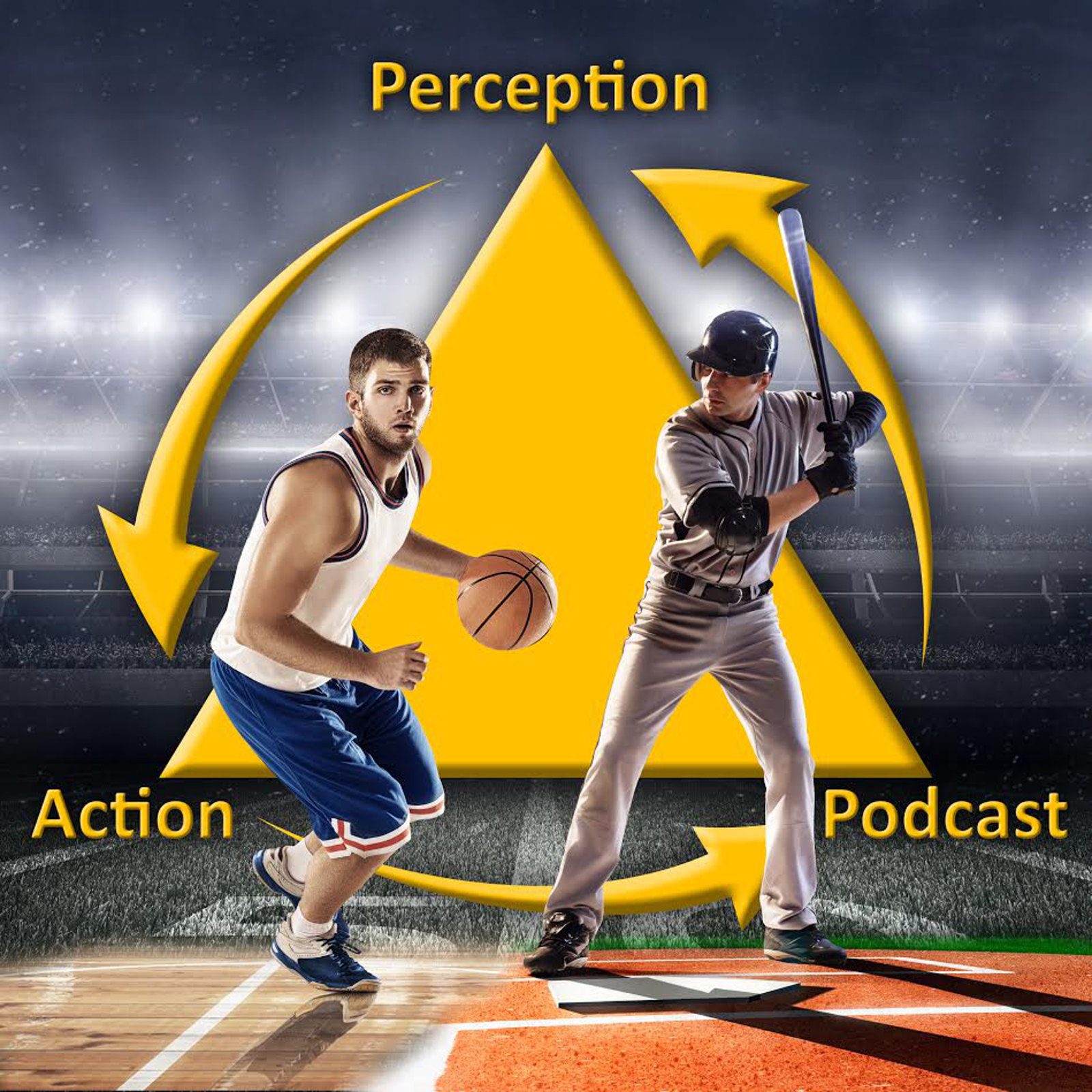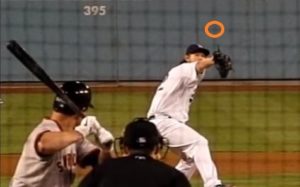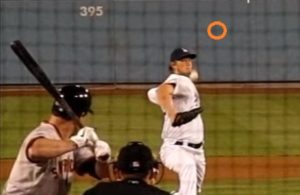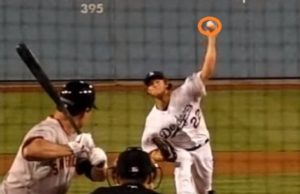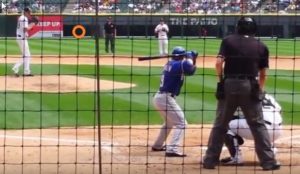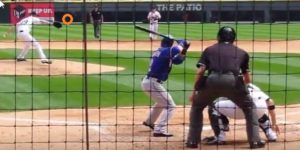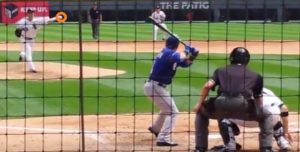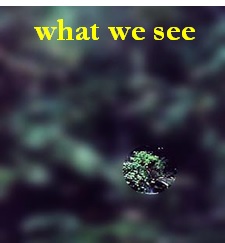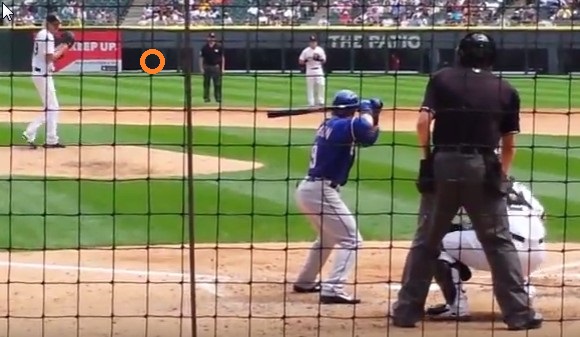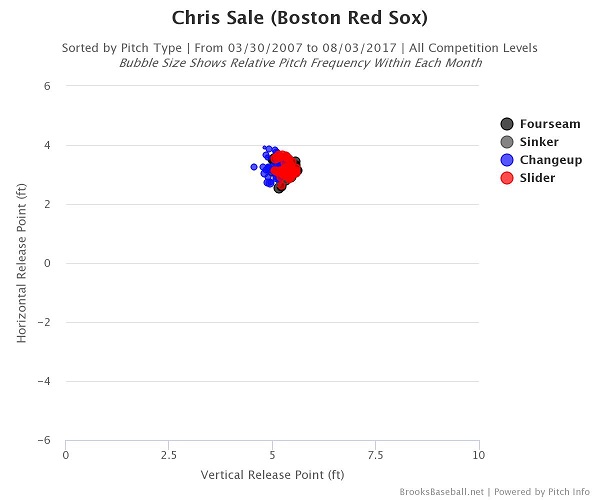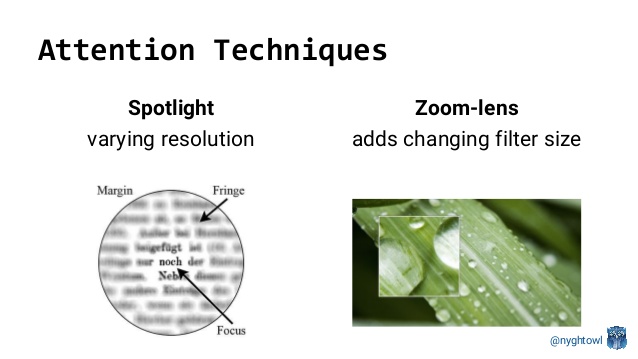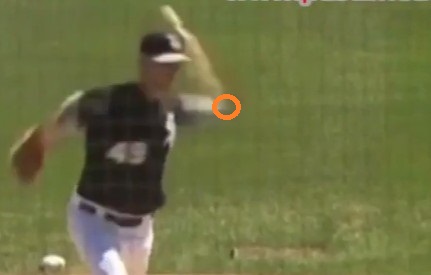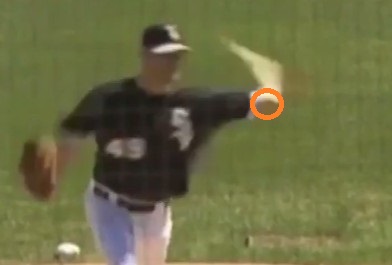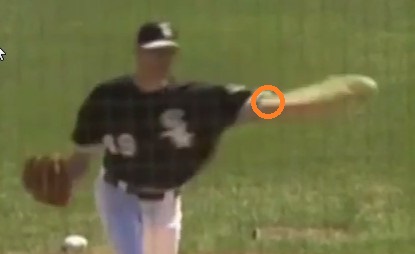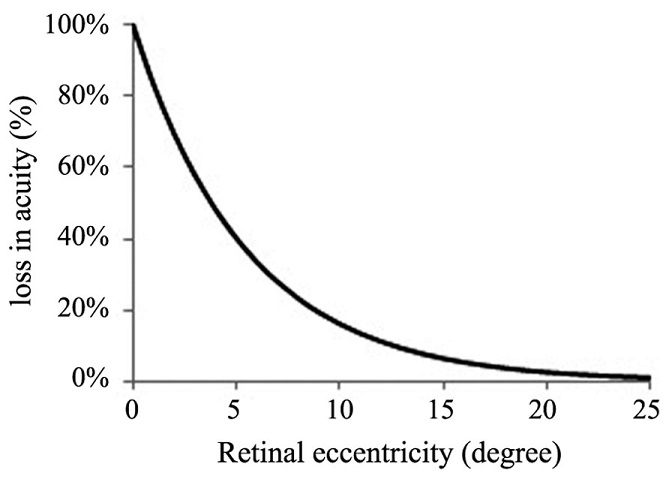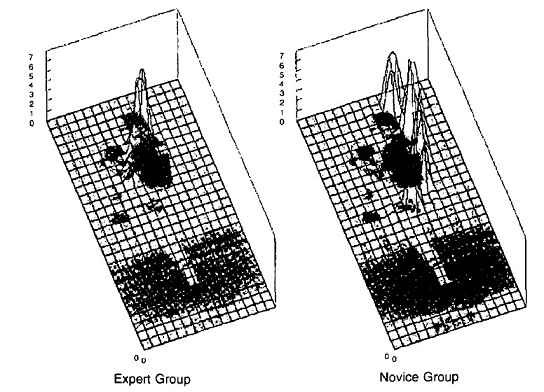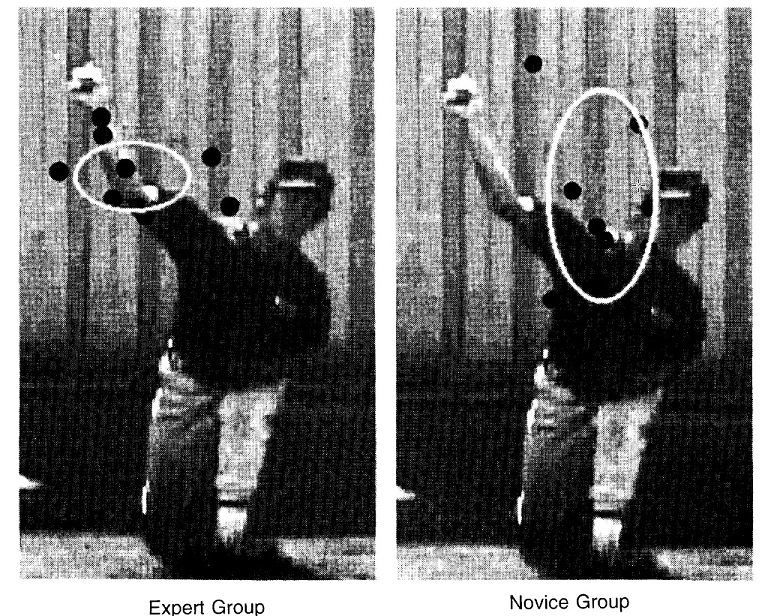[shadowbox]
“Soft Focus” or Visual Pivot Point: Which Should Baseball Batters Use?
The Challenge:
In order to hit a baseball you obviously need to be able to “see it” first. Evidence has shown that good hitters can follow the ball’s flight via eye and head movements and can pick up subtle information from the ball’s flight (e.g., the “hump” in a curveball or pattern of lace movement). So looking at the ball after it is released is important! But where should you look before it is released during the pitcher’s windup to ensure you will be able to see it clearly and track it once it starts coming at you. This is actually quite tricky. In these sequences of images of Clayton Kershaw and Chris Sale the orange circle shows the position where the ball will be upon release at three different points in the delivery.
I deliberately choose these examples because you can clearly see the protective screen behind the plate which gives a nice coordinate system for specifying location. But, of course, the batter does not see this! The problem here is that, at the start of their delivery, the release point can be quite far from the pitcher’s body and there may not be a clear visual reference point near the release point for the batter to fixate their eyes on. So, in the Chris Sale example, if the batter wanted to keep their eyes fixated on the eventual release point they would need to keep looking a couple feet to the right of the red sign on the outfield wall while Sale is going through all his gyrations slightly to left of that. What are the possible strategies a batter could use in this situation?
A reminder about how vision works before we get started
We only have clear, high resolution vision in the very small area (about 1 deg of visual angle) in the center of our vision which we call foveal vision. For reference, 1 deg is about the size of your thumb nail when you hold your arm straight out. Or, put another way, for the mound distance in baseball, we can only see clearly in an area that is the size of about 4 baseballs across. OK, with that in mind, on to the strategies:
Strategy #1 – Visually scan the pitcher during the delivery then move eyes to release point
One possible strategy a batter could use would be to move their foveal vision around the pitcher’s body during the delivery (e.g., to their glove then head then lead leg, etc) then shift their eyes to the release point during the last moment before the ball is released. On the plus side, this would be the most effective way to pick up advance cues from the pitcher’s kinematics (i.e., if they are tipping pitches). But there also is a clear downside. Getting foveal vision to the release point will likely required a saccadic eye movement. Saccades involve quickly moving the center of our vision from one place to another. The problem is this can take 30-40 ms (or about 10% of the flight time of an MLB fastball) depending on the distance to be traveled, there is a speed-accuracy tradeoff, and we are actually completely blind during a saccade (an effect called saccadic suppression). For a great demo of saccadic suppression you can do yourself by looking into a mirror check this out.
So the bottom line is if a batter uses this strategy there is a high probability their eyes won’t be in the right spot at the right time to see the ball clearly as it is released and follow it’s movement with their eyes.
Strategy #2 – Fixate a distant target that aligns with the expected release point
Another strategy a batter could use would be to essentially ignore what the pitcher is doing and attempt to keep their foveal vision locked on the predicted location of the release point. So, looking at the image of Chris Sale again, the hitter would keep the orange circle in their foveal vision (leading to Sale being in peripheral vision) for the entire delivery.
On the one hand this is not as difficult as it sounds because most MLB pitchers have very consistent release points so its not that hard to predict the location. For example, here is 2017 data for Sale from Brooks Baseball:
On the other hand, at the actual release location (55 feet from plate, 5 ft vertical, 3 feet horizontal) there is no visual reference point for the batter to look at. So, how do they know where to look and how do they keep their foveal vision there without a target to lock onto? An obvious strategy would be to look at a distant object that is aligned with the release point location (e.g., a spot on the outfield wall). But this is problematic too. When fixating on a distant point the focusing mechanisms of our eyes (accommodation which changes the shape of the lens and vergence eye movements which turn the eyes in and out) will adjust for that distance. To see the ball clearly at the release point both of these systems will have to adjust to the new distance of 55 feet when the ball appears, which again will take time and make it less likely the ball is seen clearly right away.
Strategy #3 – Use a “soft focus”
So far I have presented the way vision (and visual attention) works using the most prominent theory, the so-called “spotlight” model. That is, when we look at something there is a small area that is clear, high resolution which is what we are paying attention to while the rest is is blurry, low resolution and mostly ignored — kind of like shining a spotlight into a dark room. In this model, the size of the area of clear vision (i.e., the size of the spotlight) is always the same. An alternative view is the “zoom lens model” (Eriksen & St James, 1986), which proposes that the area we are attending to is not a fixed size and instead we can zoom in and out like with a camera. So we can either zoom in and see a small area in high resolution or zoom out and take in a wider area (with slightly less resoultion). This image illustrates the difference:
As far as I can tell, when people use the expression “soft focus” they essentially mean zooming out. Another common expression used is the “1000 yard” stare. The idea is that instead of locking your eyes on one point and seeing it clearly, you don’t really look at anything in particular and just stare straight ahead. Then when the ball gets released you quickly zoom in to see it in detail. This is different than the first two strategies because it does not require a saccade or change in accomodation-vergence. It is really a shift in attentional focus rather than a purely visual effect.
So, in theory, this strategy doesn’t have some of the same disadvantages as the first two but it is not really understood very well. How effectively can we zoom in and out? How long does it take to do it? There is actually very little research looking into how effectively we can do this. One study I did find used stimuli like shown below where there is information (a letter specified) at two different spatial scales:
One of the main effects observed in this study was that when participants were required to shift from zoomed out (report letter formed by all the little letters, so ‘T’ in #1) to zoomed-in (report little letters, so ‘H’ in #1) they made significantly more errors and responded significantly slower as compared to when a shift was not required.
Another issue with both the “soft focus” and “hard focus on release point” (#2 above) strategies is that it will be very difficult for the batter to not respond to the bodily movements of the pitcher. In their peripheral vision, the pitcher will be moving their arms and legs around and we know that motion in our periphery is one of the single best ways to get a person’s attention and make them involuntarily move their eyes. That’s why we wave at people! This could be another reason why altered deliveries give batters such trouble — unusual gyrations are even more likely to attract attention.
4) The Pivot point strategy
The final strategy a batter might use is kind of a compromise between #1 and #2. Instead of moving their foveal vision around the pitcher’s body during the delivery (#1) or trying to keep foveal vision (i.e. “hard focus”) on the anticipated location of the release point (#2), the batter instead keeps their eyes fixated on a location that is close to the release point but provides a better visual reference to keep locked on. This is called a “visual pivot point” because the person is not directing their foveal vision to that location because they want to see what is there in high resolution. Instead, they are using it as a convenient anchor point to place the eyes so that important information can be picked up in peripheral vision.
The most obvious pivot for baseball batters to use is the elbow of the pitcher’s throwing arm. As illustrated in the sequence of images below, again for Chris Sale, for most pitchers the elbow comes into view relatively early in the delivery, stays in roughly the same location, and is not that far from the eventual release point.
Based on average male forearm length of roughly 50 cm, the release point will be about 2 deg from the elbow. As shown in the figure below, although clarity of vision will be slightly worse 2 deg away from the center of vision, it is not an enormous difference.
So, in a nutshell, the pivot point strategy seems like a good compromise. It doesn’t require a last minute adjustment (like an eye movement, change in accommodation or zooming in), it gives a clear visual reference to lock onto, and it allows the release point to be seen with relatively high resolution. But..
Which Strategy Do Baseball Batter’s Actually Seem to Use?
Kato & Fukuda (2002) had 9 expert and 9 novices batters watch a video of a pitcher’s delivery while their eyes movements were tracked. The first thing they found was that the distribution of novice eye fixation locations was larger than what was found for experts as shown in the figure below.
This suggests that novice hitters used strategy #1 (i.e., moving eyes around pitcher’s body during delivery) while experts were doing something else. When they specifically focused on the final part of the delivery before the ball was released they found this:
For the most part, experts seemed to be fixating on the pitcher’s elbow rather than the release point suggesting that strategy #4 (the pivot point) was being used.
There is also evidence for the use of the pivot point strategy in other sports. For example, Ryu et al 2013 used a very clever gaze contingent display in a basketball decision making task as shown below. Basically, there were 3 different conditions: full view of scene (left panel), central vision only where a small area in the middle of the person’s visual field moved around the scene as they moved their eyes (middle panel), and a peripheral vision only condition where the central part of the scene was always blocked with a black circle (right panel). The participant’s task was decide who to pass the ball to after watching a run of play.
The findings revealed that the expert advantage for decision making with a full visual field remained irrespective of whether skilled participants used only their central or peripheral vision. This suggests that expert basketball players can effectively employ the pivot point strategy. It would be fantastic to try to repeat this gaze-contingent experiment using an eye tracker with baseball batters.
How do these strategies relate to the “Quiet Eye”?
On the surface some of these strategies bare a resemble to the “Quiet Eye Effect” first discovered by Joan Vickers. For those that don’t know, this is the finding that more skilled athletes (across a range of different sports) tend to have a longer final fixation on their target before they initiate their movement. So elite basketball players look longer at the rim before shooting a free throw than lesser skilled ones, for example. In terms of reactive sports skills like baseball batting, it has been shown that Quiet Eye duration in ice hockey goaltenders is positively related to their save percentage. So, in other words, there is evidence that keeping your eyes still before moving results in better performance. Why exactly this is the case is still being debated with various explanations being proposed including increased time for motor planning and processing of feedback. For more on the Quiet Eye check out this episode of the podcast.
In terms of the strategies I described above, #’s 2-4 all have an element of the quiet eye in that the batter is trying to keep their eyes still during the delivery, however, they are not looking directly at the target (the ball) for the entire time so there is some difference. I think it would be interesting to do a study to determine the relationship between how “quiet” the eyes are during a pitcher’s delivery and batting performance.
Summary and Conclusions
- Where a batter should look during the pitcher’s delivery in order to allow for the clearest vision and best tracking of the ball once it is released is a challenging problem
- Strategies which require a last second eye movement or adjustment in accommodation/vergence before the ball is released are problematic because they will likely delay picking up the ball flight
- The “soft focus” strategy seems to have some benefits but it is unclear how well it can actually be executed
- The visual pivot point strategy seems to provide the best solution to this challenge and there is some evidence it is what skilled batters actually use
- In a future post I will look at how “hiding the ball” during the delivery effects all of this
[/shadowbox]
